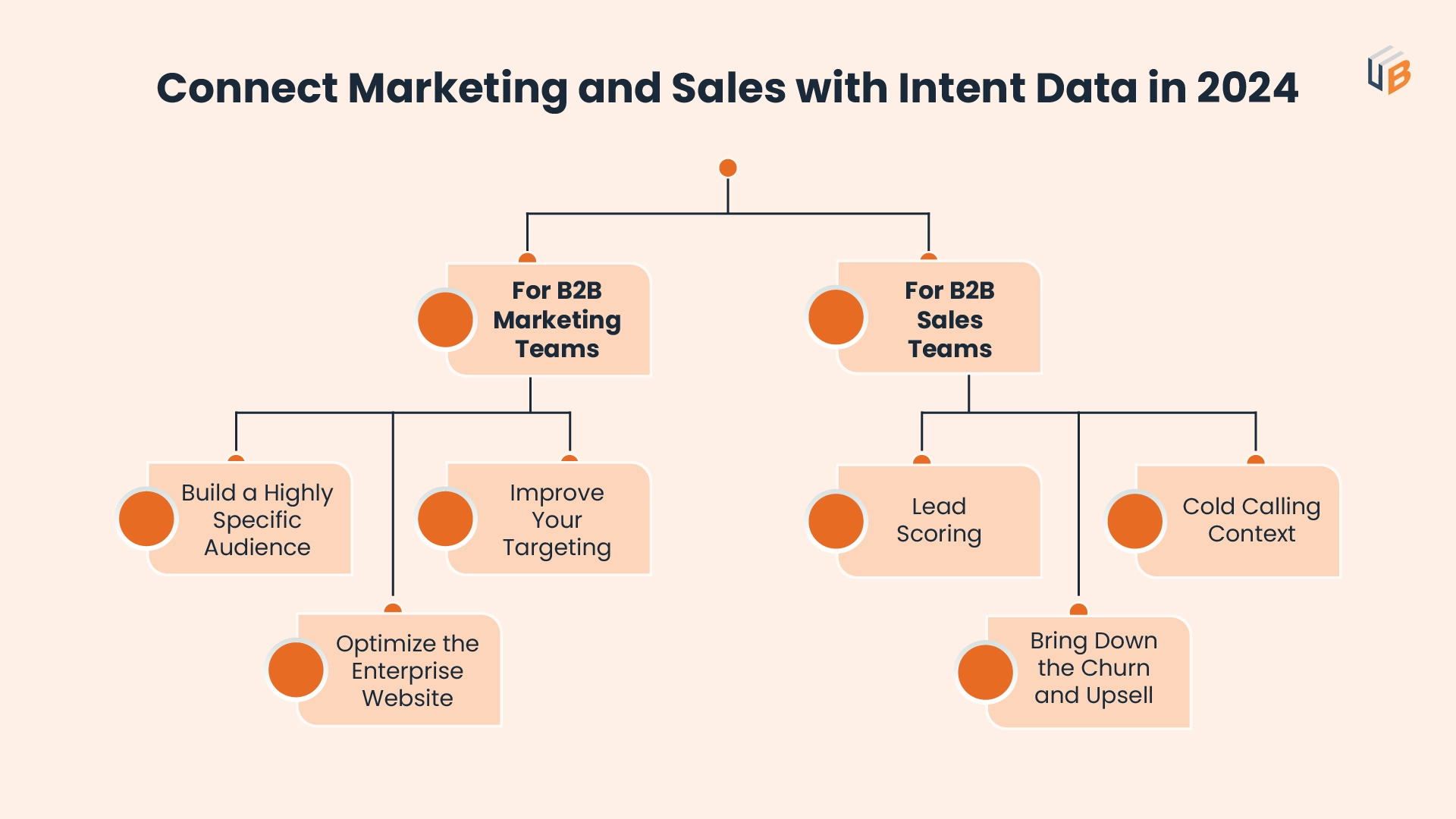
Not getting carried away by the company’s size, sales and marketing alignment is a crucial part of B2B businesses. We have seen the benefits of leveraging intent data to build MarTech stack. In 2024, it is time to integrate intent data to diminish the gap between sales and marketing.
Intent data explains the online behavior of your target audience and predicts whether the prospects will make a buying decision in your company. Sales and marketing teams often use it but mostly not to its full potential. Therefore, making a sales and marketing alignment strategy with the help of intent data in 2024 is ideal.
An empowered buyer is exactly what a sales and marketing organization should be targeting. Sales and marketing should unite to determine who their ideal customer is and how to reveal their latent pain and to move the customer to a place where they are more successful because of the product or service being offered.
— Claudine Bianchi, QAD Redzone
But before we proceed, let us see why this bridging the gap part is so fundamental and what the challenges are in it.
Why Is Sales and Marketing Alignment Important to Business?
Enterprises that are putting efforts into reducing the gap between their sales and marketing teams in 2024 enjoy a multitude of benefits. The fundamentals are as follows,
1. Improved Lead Generation
Sales and marketing collaboration creates a mutual understanding between the teams. This is helpful as it makes a common goal of generating quality leads and nurturing the process. These teams when working together set clear goals, utilize resources and revenue properly, thus providing maximum leads with optimum use of resources.
Marketing teams can tailor content suitable to the prospects your enterprise is targeting. You can also prepare an omnichannel marketing strategy to nurture and collect leads. This team collaboration is excellent as the lead generation and lead management processes both get simpler. Targeted customers get personalized messages from marketing team and sales team nurtures the prospects.
2. One Step Ahead of Competition
Most organizations conduct competitive analysis from time to time to understand what their competitors are doing. This way businesses get an edge against the competition and create opportunities for themselves. These analyses also show you the threats and weaknesses of your company and the advantages and strengths you have above all your competitors.
When you bridge the gap between sales and marketing, the sales team can provide you with their experience of customers with them and how it can be changed given the market. Marketing teams can give knowledge of what worked in their strategy and prospects’ behavior and pattern to it.
3. Revenue-aligned Strategies
It is easier to meet common goals than running to accomplish different goals. So when teams make strategies that can align with your revenue, you reach the goals smoothly. Both teams bring their expertise to the table and make collaborative activities to support greater success.
Marketing team can provide sales team with an understanding of target customers, their setbacks, expectations, and industry trends. On the other hand, sales team can provide feedback on their outreach calls to help improve marketing efforts.
What Are the Barriers to Sales and Marketing Alignment?
According to research, 87% of sales and marketing leaders believe that alignment between their teams is essential to business growth — but an even higher majority say it’s nearly impossible to accomplish. Here’s why it is nearly impossible to accomplish,
1. Unclear Communication
For sales and marketing alignment, it is fundamental to have clear channels of communication otherwise, barriers will continue to exist. The confusion stays between the teams if they lack communication. This means they work differently, obtain different results and the overall strategy fails.
Also, companies introduce programs in the hopes that this will provide a channel for them to align, and that only adds an extra layer of complexity.
There is always a need to create communication standards for them to work efficiently. Agreeing on a plan, executing it and continuous refinement is the only solution for good communication.
2. Misfocused Priorities
Companies need to set priorities for all the teams that lead to a united result. If all the teams work in a different direction, they will never reach a result that meets the vision. So all the efforts and resources are wasted.
Marketing aims to get more leads and sales main focus is on converting them. But if the leads don’t convert to sales, there are just losses and misjudgment and nobody wins. So the solution to this is to set your priorities the same for both teams and see success following.
3. Competing Goals
Oftentimes, marketing and sales inhibit competing goals and it becomes a barrier to being effective. This is because marketing teams are running toward getting maximum leads and the sales team is putting all their efforts into converting them.
But, it is going wrong in a way that sales team will face problems in converting them and will convey to the marketing team that they are sending bad leads.
On the other hand, marketing team will react by creating new tactics and strategies to bring good leads. This gets exhaustive for both teams and there are no suitable results too. Until both teams don’t work together for a common goal, they will continue to disconnect.
How Do You Connect Marketing and Sales with Intent Data in 2024?
Now that you have understood the importance and barriers of sales and marketing alignment. It is time we see a solution that integrates with intent data to bring optimized results in 2024. Intent data provides different insights for both sales and marketing so once you infuse it in your strategy, you will see how seamless the gap bridges.

For B2B Marketing Teams
Marketing intent data is about the prospect’s online behavior and buying decisions. You can infuse intent data by,
1. Build a Highly Specific Audience
With the assistance of intent data, you can create really specific ad campaigns for your audience. However creating a highly specific pool of target audience is crucial, as it helps in bringing them into sales funnel and nurturing them.
Intent data provides an understanding of which companies are interested in your product or service, their purchasing intent, and their level in the sales funnel. This will help you present ads to the right people.
2. Improve Your Targeting
Once you have decided on your audience, you will understand your ICP properly. This will help you in choosing which group of buyers are most likely to buy your products. These are the people you should target.
Make sure your team has good intent scoring to create highly personalized campaigns that will result in intent data lead generation and better conversions.
3. Optimize the Enterprise Website
Another benefit of intent data is that you can make changes to your website that fit with your audience. The data doesn’t stay the same forever, so you will need to make adjustments from time to time. Changes in specific industries can differ in the adjustments.
So while optimizing the website, create specific pages for more frequent prospects and visitors. You can also make certain e-books, case studies, and whitepapers easily accessible for these visitors and provide B2B industry-specific information.
For B2B Sales Teams
With intent data, sales specialists can have huge revenue generation opportunities, saving resources and time.
1. Lead Scoring
Lead scoring is a process of prioritizing and qualifying the leads. So you give a score to your leads and then reach out to them based on their score. If you have multiple outbound sales leads, lead scoring can come in handy.
You must be thinking what’s the best way to score a lead? The simplest answer to it is intent. Intent data can help you rank prospects based on their buying intent. In the end, you will have a well-structured list of prospects followed by who to contact first.
2. Cold Calling Context
If you have the information of what companies prospects are searching for and the type of company you are, you can have a meaningful call with them. You will be able to find out why they are seeking your services and you don’t have to initiate your cold call by pain points as you will already know it.
3. Bring Down the Churn and Upsell
It is no secret that it is more cost-effective to retain a client than to find new ones. Intent data allows you to see what features or services your clients are looking for. You may find that the features they are looking for are not provided by you. So you either add those features to your organization or lose the client. This helps you find innovations and diminish the gaps in your product.
There is Still Hope for Bridging the Gap
Intent-based marketing is a valuable tool and no one is denying that. The better the conversion rates, the better your business is performing. With sales and marketing, to bring the best results you will need to have a greater alignment to focus on common goals and meet the larger mission. So when you integrate intent data into it, you will witness improved campaigns, better communications, and better results.
Our blog
Latest blog posts
Tool and strategies modern teams need to help their companies grow.

Running a business comes with its own set of challenges, especially when it comes to ...

AI is surely a futuristic concept but it evolves today, particularly in sales and mar...

A successful webinar requires more than just a great speaker and a compelling topic. ...







